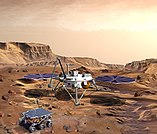

 
Artworks of the orbiter (left) and surface elements (right) that would have been used in the mission
| |
| Spacecraft properties | |
|---|---|
| Spacecraft |
|
| Manufacturer |
|
The Mars Surveyor 2001 project was a multi-part Mars exploration mission intended as a follow-up to Mars Surveyor '98. After the two probes of the 1998 project, Mars Climate Orbiter and Mars Polar Lander, were both lost, NASA's "better, faster, cheaper" exploration philosophy was re-evaluated, with a particular eye on the two 2001 project probes. As a result, the mission, along with the launch of its lander and rover, were canceled in May 2000, but the decision was made to continue development with its orbiter counterpart. The orbiter launched as 2001 Mars Odyssey in April 2001, in a mission independent of the Mars Surveyor project, and reached Mars in October 2001. After being placed in a cleanroom in 2001 and stored since, the nearly-completed lander component was eventually reused to fly the Phoenix mission,[1] which launched in August 2007 and landed successfully on Mars in May 2008.

The 2001 Surveyor lander spacecraft was built under contract to NASA by the Lockheed Martin corporation. Except for the solar arrays, the basic lander design is identical to that of the Mars Polar Lander, which had been intended to be the first of a series of low-cost "Mars Surveyor" landers sent to Mars. The 2001 Surveyor lander was also intended to carry to Mars a test payload, MIP (Mars ISPP Precursor), that was to demonstrate manufacture of oxygen from the atmosphere of Mars,[2] as well as test solar cell technologies and methods of mitigating the effect of Martian dust on the power systems.[3] MIP's overall external envelope is approximately 40 x 24 x 25 cm (15.7 x 9.4 x 9.8 inches), and its mass is 8.5 kg (18.7 lb).[2] Most of the top surface was covered by various types of solar cells. MIP included five experiments :[2]
After the failure of the Mars Surveyor 98 mission, the launch of the Mars Surveyor 2001 lander was cancelled in May 2000, and the near-completed spacecraft was placed in an environmentally controlled cleanroom from 2001 by Lockheed Martin.[4] The spacecraft was offered as government furnished property to investigators proposing missions to the Mars Scout Program, and the spacecraft was used as the lander on the Phoenix mission; it is currently on Mars in the north polar region. In addition to using the 2001 Surveyor Lander, three of the experiments flown on the Phoenix mission are instruments that were originally built for the Mars Surveyor 2001 Lander:
Prior to mission cancellation, cost overruns and technical problems caused the Lander design to be rescoped, and the planned large Athena rover was replaced by a small rover, named Marie Curie, that was a flight spare to the Sojourner which was a part of the Mars Pathfinder mission. (The Athena did later make it to Mars, however, with two such rovers making up the Mars Exploration Rover Mission of 2004. The second of these, MER-B Opportunity, landed at Mars Surveyor 2001 Lander's target site, Meridiani Planum.)
|
| |||||||||||
|---|---|---|---|---|---|---|---|---|---|---|---|
| |||||||||||
| Active |
| ||||||||||
| Past |
| ||||||||||
| |||||||||||
| Future |
| ||||||||||
| |||||||||||
| Exploration |
| ||||||||||
Missions are ordered by launch date. Sign † indicates failure en route or before intended mission data returned. | |||||||||||